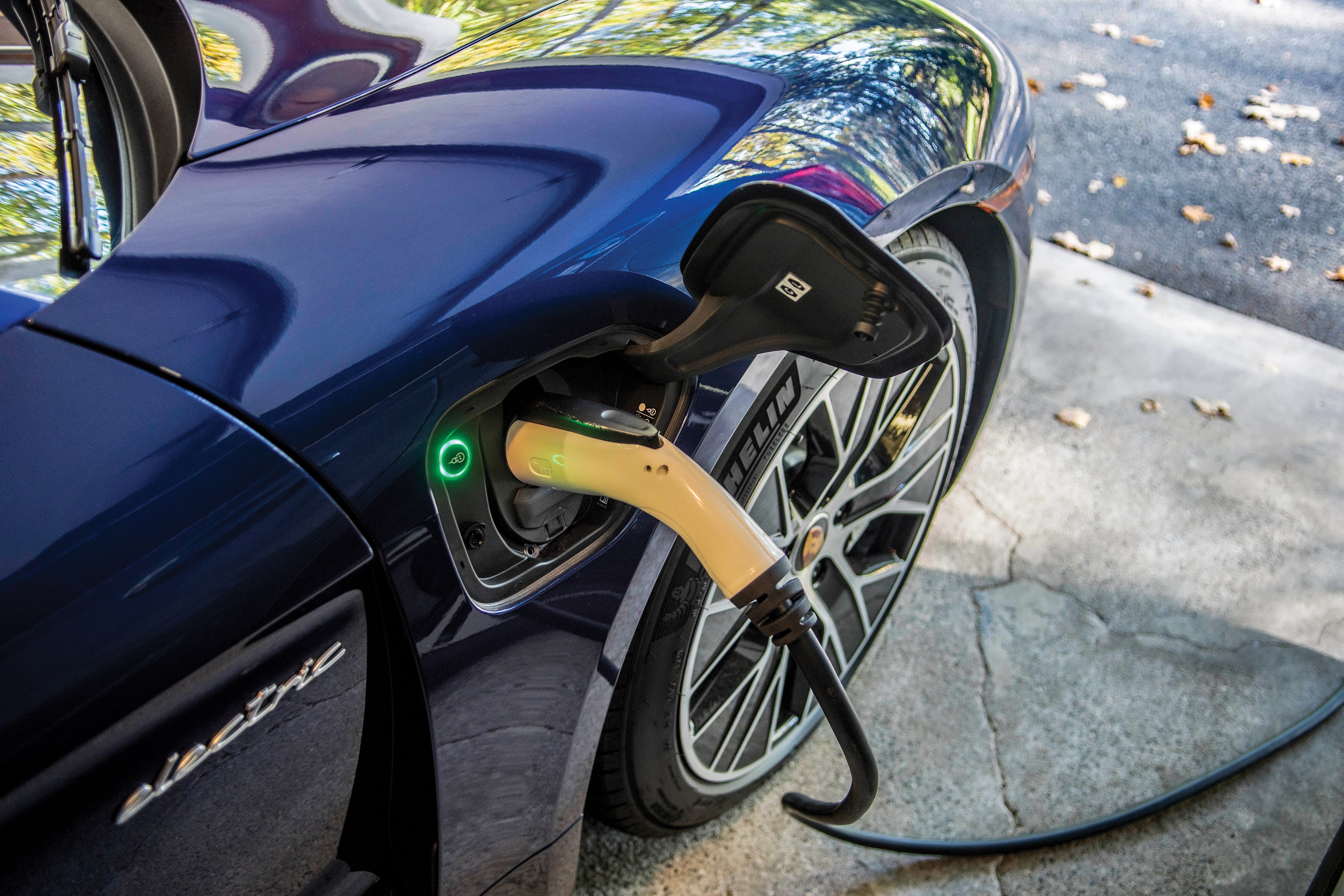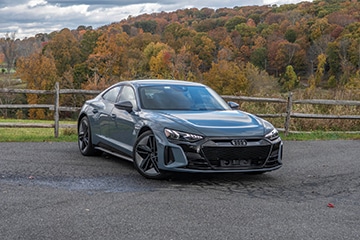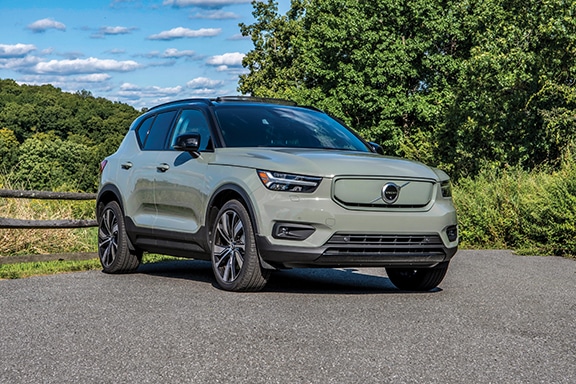Charging Ahead – EV’s are taking the industry by storm
by Roger Garbow
Photography by Roger Garbow
Light Painted Porsche Photo by Will Cook
No matter what you think of Elon Musk, it’s impossible to ignore that Tesla, the electric car company he founded, has dramatically altered the global automotive landscape. Tesla’s success has forced every major auto manufacturer back to the drawing board to pen their own EVs.
Nowhere is the revolution more evident than in Detroit, where Ford is now selling an electric “Mustang” and launching an electric F-150 Lightning pickup, while GM is resurrecting that posterchild of consumption, the Hummer, as an electric truck. The Hummer EV has 1,000 horsepower, so excess hasn’t totally left the building. To see how they handle day-to-day life in the suburbs, we test drove a few new EVs.
Porsche Taycan
 Porsche eased into electrification by adding a hybrid drivetrain to the Cayenne SUV way back in 2010 and the Panamera sedan a year later. Unlike their hybrid efforts, the new Porsche Taycan was designed from the ground up as an EV and features a skateboard style chassis preserving the exceptional handling Porsches are known for.
Porsche eased into electrification by adding a hybrid drivetrain to the Cayenne SUV way back in 2010 and the Panamera sedan a year later. Unlike their hybrid efforts, the new Porsche Taycan was designed from the ground up as an EV and features a skateboard style chassis preserving the exceptional handling Porsches are known for.
My Taycan Turbo test car is one of eight models in the Taycan range and features both sedan and Cross Turismo (wagon) versions. The Turbo delivers up to 670 hp and 275 miles of range (according to AMCI Testing). Want to impress your friends and terrify your in-laws? Engage launch control and the Turbo will hit sixty mph in 3 seconds (2.5 seconds in the Turbo S). It feels even faster since the brutal acceleration is accomplished without the roar of engine or exhaust, just a pleasant futuristic soundtrack. One of my favorite options on the Taycan is the Passenger Display. This additional touchscreen allows the passenger to program navigation or choose the music while the driver focuses on driving. Brilliant!
Audi e-tron GT
 Joining the Audi e-tron SUV family, the new e-tron GT sedan is a cousin to the Taycan, utilizing the same basic platform. Where the Audi differs is in the interior and exterior styling and suspension tuning. My RS e-tron GT test car is the top model with 637 hp. Using a DC fast charger, the GT can go from 5% to 80% charge in only 22 minutes making road trips easy. The RS sits low, but the suspension is adjustable for both firmness and ride height to keep you from scraping that lovely face. And it’s pretty. I think the GT might be the most beautiful sedan currently available. The interior is typical Audi perfection with excellent ergonomics and supportive yet comfortable seats that offer massaging as an option. Both the Audi and Porsche smartly feature charge ports on both
Joining the Audi e-tron SUV family, the new e-tron GT sedan is a cousin to the Taycan, utilizing the same basic platform. Where the Audi differs is in the interior and exterior styling and suspension tuning. My RS e-tron GT test car is the top model with 637 hp. Using a DC fast charger, the GT can go from 5% to 80% charge in only 22 minutes making road trips easy. The RS sits low, but the suspension is adjustable for both firmness and ride height to keep you from scraping that lovely face. And it’s pretty. I think the GT might be the most beautiful sedan currently available. The interior is typical Audi perfection with excellent ergonomics and supportive yet comfortable seats that offer massaging as an option. Both the Audi and Porsche smartly feature charge ports on both
front fenders.
Volvo XC40 Recharge/Polestar 2
 Volvo and its new sister (cousin?) brand Polestar, are getting serious about electrics. While Volvo has been offering plug-in hybrid versions of its cars for years, the fully electric XC40 Recharge is new. Powered by two motors producing 402 hp and 486 lb-ft, this compact luxury SUV will make your IKEA runs a cinch. The Recharge is based upon the gas-engine XC40, retaining the functional, attractive interior and adorable exterior. Like all Volvos, the seats are superbly comfortable and supportive. In spite of the shared platform, the Polestar 2 couldn’t be more different than the Volvo. With a more minimalist interior featuring vegan materials and a very stylish hatchback/notchback exterior, the 2 is aimed directly at Tesla’s Model Y. The Polestar has sportier handling than the Volvo by design and helped in no small part by my test car’s optional Performance Pack which includes adjustable Öhlins dampers and great looking Brembo brakes with gold calipers. Both the Volvo and the Polestar feature an Android infotainment system with Google apps built in. While I’m an iPhone guy, it’s hard to beat Google’s voice recognition and navigation services.
Volvo and its new sister (cousin?) brand Polestar, are getting serious about electrics. While Volvo has been offering plug-in hybrid versions of its cars for years, the fully electric XC40 Recharge is new. Powered by two motors producing 402 hp and 486 lb-ft, this compact luxury SUV will make your IKEA runs a cinch. The Recharge is based upon the gas-engine XC40, retaining the functional, attractive interior and adorable exterior. Like all Volvos, the seats are superbly comfortable and supportive. In spite of the shared platform, the Polestar 2 couldn’t be more different than the Volvo. With a more minimalist interior featuring vegan materials and a very stylish hatchback/notchback exterior, the 2 is aimed directly at Tesla’s Model Y. The Polestar has sportier handling than the Volvo by design and helped in no small part by my test car’s optional Performance Pack which includes adjustable Öhlins dampers and great looking Brembo brakes with gold calipers. Both the Volvo and the Polestar feature an Android infotainment system with Google apps built in. While I’m an iPhone guy, it’s hard to beat Google’s voice recognition and navigation services.
Part of the equation you need to consider when purchasing an EV is how you’ll charge it. For those who own their own home, I strongly recommend installing a level 2 charger which can give you a full charge in a few hours. While you can plug into a standard 110-volt outlet, charging that way is frustratingly slow. Level 2 chargers run off a 240-volt circuit (like a dryer outlet)with prices ranging from $200 to over $1,000 depending upon the brand and features you want. You’ll also need to hire an electrician to wire it up. As EV industry expert John Voelcker recommends, “if you are installing in your garage, you should consider a 240-volt outlet and a plug instead of hard wiring the unit. This way, you can easily upgrade or take the charger with you if needed.” I have a level 2 charger in my garage and I can’t tell you how satisfying it is to wake up to a “full tank” each morning. •